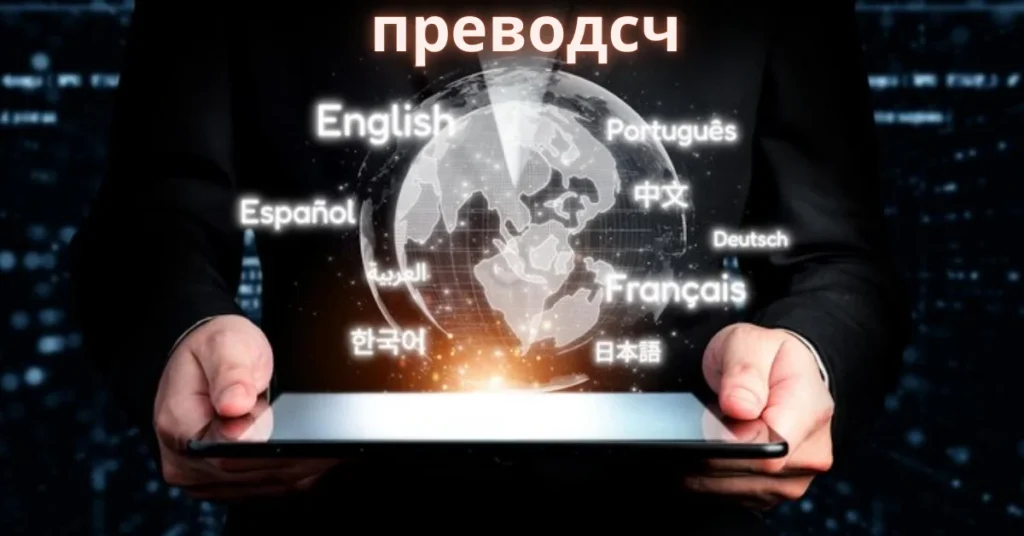Navigating between languages is much like crossing a river: the width might be daunting, but with the right tools and techniques, one can bridge the gap with elegance and precision. In this article, we delve into the intricacies of translation, exploring the concept of “преводсч”—a term that encapsulates the art of translating with utmost precision—and how modern approaches are transforming the way we bridge language barriers. Sit back, relax, and join me on this journey through the fascinating world of linguistic transitions and cultural exchanges.
Introduction
Language is not just a medium of communication; it’s a vessel carrying culture, history, and personal identity. The need to translate and communicate across languages has driven innovation and creativity throughout history. Translators and interpreters act as the unsung heroes who create connections between different worlds. But how do we ensure that these connections are as accurate and meaningful as possible? This is where the art of преводсч shines, combining skill, technology, and intuition.
Background of Language Barriers
Language barriers are more than just differences in words—they encompass cultural nuances, idiomatic expressions, and contextual meanings that can vary significantly from one language to another. Imagine trying to decode an inside joke from another culture without understanding the context; it would be nearly impossible to grasp the full meaning. Translators walk this tightrope daily, balancing accuracy with cultural sensitivity.
Importance of Effective Translation
Effective translation is crucial in today’s globalized world. It fosters international trade, diplomacy, education, and social integration. Whether you’re reading a bestselling novel translated into your native tongue or engaging in business negotiations with partners overseas, the quality of translation can make all the difference. Here, precision isn’t just a fancy term—it’s the lifeline of clear and effective communication.
Understanding преводсч and Its Relevance
Before diving deeper into the modern landscape of translation, it’s essential to understand the term “преводсч.” More than a simple translation mechanism, преводсч embodies the precision and attention to detail necessary for bridging language gaps.
What Does преводсч Mean?
“преводсч” is a concept that revolves around precision in translation. It encourages translators to go beyond a literal word-to-word conversion and instead capture the essence, emotions, and cultural subtleties that every language conveys. In doing so, преводсч paves the way for a more nuanced and authentic exchange of ideas across linguistic borders.
The Role of Precision in Translations
Precision in translation is akin to using a finely-tuned instrument; even the slightest misstep can lead to significant misinterpretations. Think of it as crafting a delicate piece of art—every brush stroke matters. It’s about preserving the original content’s spirit while ensuring it resonates with the target audience. This level of meticulousness not only improves clarity but also deepens the connection between disparate cultures.
Historical Perspective on Language Bridging
The art of translation is as old as civilization itself. Early translations played a pivotal role in the exchange of wisdom, literature, and scientific discoveries.
Early Translation Methods
Historically, translations were performed by scholars, monks, and interpreters who painstakingly converted ancient texts from one language to another. These early pioneers laid the groundwork for cross-cultural communication, even when faced with limited resources and tools. Their legacy is a reminder that translation has always been an art form that requires dedication and deep understanding.
Evolution with Technological Advancements
The translation landscape underwent a major transformation with the advent of new technology. From handwritten manuscripts to the printing press, and eventually to digital era innovations, the methods of translation have continuously evolved. Today, technology plays an indispensable role in modern translation, enhancing speed and accuracy through sophisticated algorithms and machine learning models. Yet, despite these advancements, the human element remains irreplaceable, embodying the nuanced touch of преводсч.
The Art of Bridging Language Barriers
The journey of a translator is never a straight path. It is filled with both triumphs and challenges that require a deep understanding of both the source and target languages.
Embracing Cultural Nuances
Language is deeply embedded in culture, and every phrase carries layers of meaning that extend beyond the dictionary definition. Translators must immerse themselves in the cultural context to truly capture these subtleties. Whether it’s a metaphor that resonates with local traditions or an idiom that encapsulates regional humor, appreciating these nuances is critical for effective translation.
Importance of Slang and Idioms
Slang and idioms are particularly challenging areas. They can be tricky to translate because their meanings often rely on shared cultural experiences. Much like a secret handshake between friends, these expressions forge a unique connection with the audience. A skilled translator understands that maintaining these flavors is vital to preserving the text’s authenticity and emotional impact.
Overcoming Linguistic Challenges
Every language comes with its own set of peculiarities—grammar rules, syntax, and contextual cues that don’t always have a one-to-one correspondence in another language. Overcoming these challenges is where the magic of преводсч truly comes to life. Translators blend creativity with technical knowledge, ensuring that the transformed message maintains its integrity while sounding natural and engaging.
Technological Innovations in Translation
In an increasingly digital world, technology has become a powerful ally in the field of translation. However, while machines can process data in milliseconds, they cannot fully capture the human touch that effective translation demands.
From Human Translators to AI
AI-powered translation tools have revolutionized the way we approach language conversion. Services such as machine translation engines can now quickly produce translations of vast amounts of text. Yet, these tools are best regarded as assistants rather than replacements. The nuanced understanding required for преводсч is best achieved when human intuition guides the process, ensuring that cultural context and emotional tone are not lost in translation.
Future Trends in Machine Translation
Looking forward, we can expect even more sophisticated advancements in machine translation. Innovations like neural networks and deep learning promise to further narrow the gap between raw computational power and the finesse of human translators. The goal is not to replace humans but to provide them with enhanced tools that bolster precision and efficiency. The interplay between human expertise and technological innovation is set to redefine the future of translation.
Best Practices for Quality Translation
Achieving excellence in translation demands more than mere linguistic competence—it requires a strategic approach that considers various elements of the communication process.
Effective Translation Strategies
- Thorough Research: Before translating, it’s essential to dive deep into both the source material and the target language’s cultural context.
- Contextual Interpretation: Rather than translating word-for-word, focus on the overall meaning and intention behind the text.
- Regular Reviews: Quality assurance through proofreading and peer reviews is crucial to catch nuances that might otherwise be overlooked.
Maintaining Accuracy and a Natural Flow
A translation should not feel stilted or mechanical; it ought to read as if it were originally written in the target language. This is where precision meets artistry. A well-crafted translation has the power to bridge gaps and invoke the same emotions as the original, ensuring that the audience remains engaged and connected to the content.
Application of преводсч in Various Fields
The principles of преводсч extend far beyond literary translations. They find relevance in multiple sectors, each with its own unique challenges.
Business and Commerce
In the corporate world, effective translation is the backbone of global outreach and international partnerships. Whether it’s translating legal documents, marketing materials, or product manuals, precision is vital. A clear, concise, and culturally appropriate translation can be the difference between sealing a deal and facing miscommunication that could derail an entire business venture.
Media, Literature, and Art
In media and literature, the power of translation lies in its ability to transcend boundaries. Books, films, and music often capture universal themes, yet their impact is amplified when they are accessible in multiple languages. Translators must balance literal conversion with the creative interpretation that preserves the artistic essence of the work, ensuring that every emotion and nuance shines through.
Overcoming Challenges in Translation
No matter how skilled or technologically advanced, both human translators and machines encounter hurdles that threaten the clarity of the translated message.
Dealing with Ambiguities and Contextual Pitfalls
Ambiguities in the source text are among the most common challenges. Words with multiple meanings, cultural references, and idiomatic expressions can become sources of confusion. Translators must work diligently to interpret the intended meaning based on context—much like solving a puzzle where every piece must fit perfectly.
The Importance of Context and Adaptability
Adaptability is the cornerstone of effective translation. The translator’s role is not static; it requires constant adjustment and reevaluation as new contexts and meanings emerge. By blending deep cultural insights with a flexible approach, practitioners of преводсч ensure that their translations remain accurate, relatable, and resonant with the audience.
The Future of Bridging Language Barriers
As global communication continues to expand, the need for precise and culturally attuned translation grows ever more critical.
Innovations on the Horizon
The future holds promising innovations that promise to make translations even more accurate and efficient. With emerging technologies in artificial intelligence, augmented reality, and semantic analysis, the tools available for translation are set to become more intuitive, adaptive, and user-friendly. These advancements will further empower translators to deliver a truly immersive and precise experience—allowing languages to intertwine in ways previously unimaginable.
Continuous Learning and Adaptation
At the heart of преводсч is the commitment to continuous improvement. Translators must consistently update their skills, embrace new technologies, and adapt to the evolving linguistic landscape. This ongoing learning process not only refines their craft but also ensures that they remain adept at navigating the complexities of language in an ever-changing world.
Conclusion
Bridging language barriers is no simple feat—it is an art that thrives on precision, passion, and a deep understanding of cultural nuances. The concept of преводсч encapsulates these ideals, serving as a reminder that translation is much more than converting words; it is about creating bridges between hearts and minds. Whether you’re a business professional seeking to expand your global footprint or an avid reader exploring literature from different cultures, appreciating the delicate balance between accuracy and artistry can enrich your experience. Embracing both the human touch and the innovative thrust of technology, the future of translation is set to break down barriers and foster a truly interconnected world.
FAQs
What exactly does преводсч mean?
преводсч embodies the art of precise translation, emphasizing accuracy, cultural understanding, and the nuance needed to bridge linguistic and cultural gaps.
How has technology influenced modern translation practices?
Technology, including AI and neural networks, has greatly enhanced translation speed and accuracy, yet the nuanced understanding provided by human expertise remains indispensable.
What are some common challenges in translating idioms and slang?
Idioms and slang often rely on cultural contexts and shared experiences. Translators must interpret these expressions carefully to maintain their original flavor and meaning in another language.
Can machine translation fully replace human translators in the future?
While machine translation continues to improve, the nuanced and context-sensitive art of преводсч shows that human intuition and cultural sensitivity are irreplaceable assets in the translation process.
What best practices can ensure the quality of a translation?
Effective research, contextual interpretation, iterative revisions, and a balanced integration of technological tools are all essential to maintain translation quality and ensure both accuracy and natural flow.






